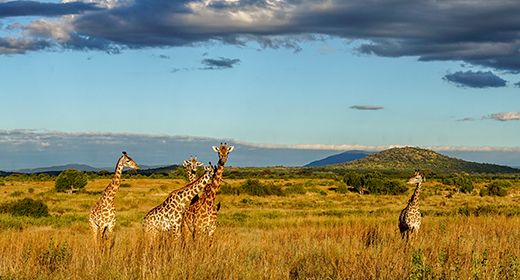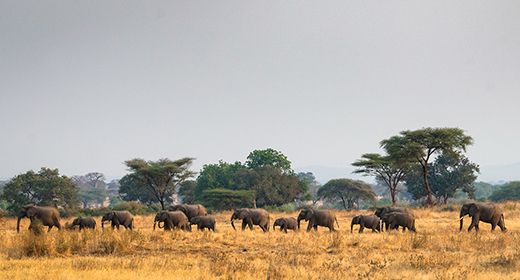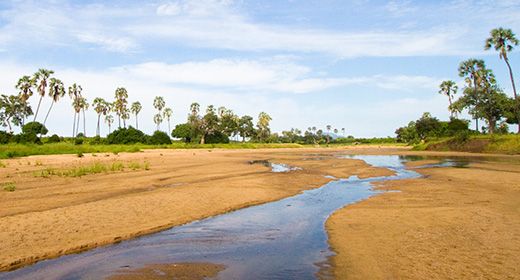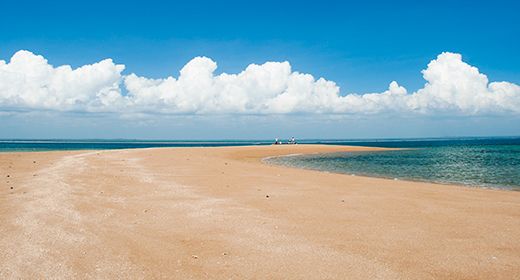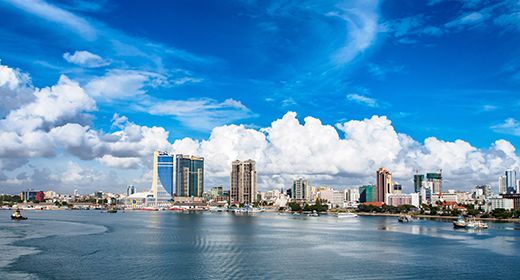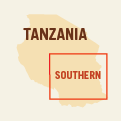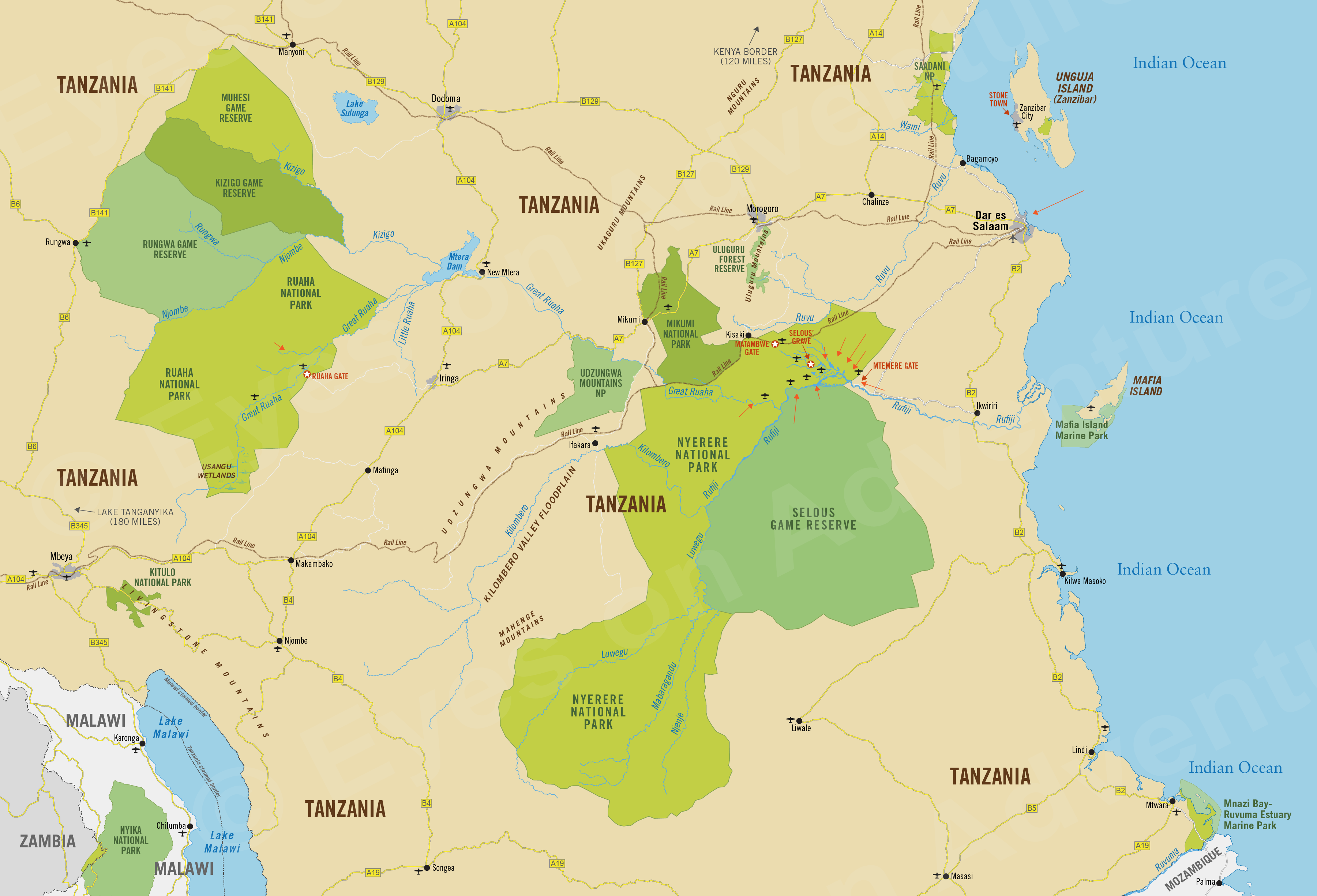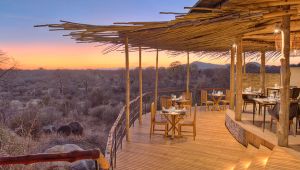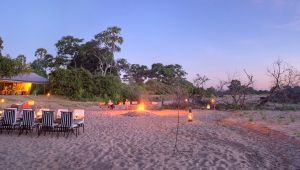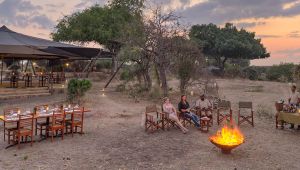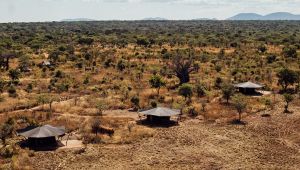Southern Tanzania
(incl. Nyerere, Selous, Ruaha, Saadani, Udzungwa Mountains, Dar Es Salaam)
Region Links: Great Migration, Kilimanjaro & Arusha, Ngorongoro & Manyara, Serengeti, Southern Tanzania, Tarangire, Western Tanzania, Zanzibar
Highlights
- Selous/Nyerere is the largest wildlife sanctuary in Africa
- Ruaha National Park offers superb safaris and no crowds
- Saadani National Park protects wildlife on the Indian Ocean coast
- Udzungwa is an unspoiled and remote montane rainforest
- Dar es Salaam is an historic city on the Indian Ocean
EOA Recommends: Azura Selous, Beho Beho Camp, Jabali Ridge, Jongomero Camp, Ras Kutani, Siwandu Camp
Tanzania's southern safari circuit includes two wildlife gems: the combine Nyerere National Park / Selous Game Reserve and Ruaha National Park. Both offer a true wilderness experience, diverse and abundant wildlife, and few to no tourists. The safari experience is like stepping back in time.
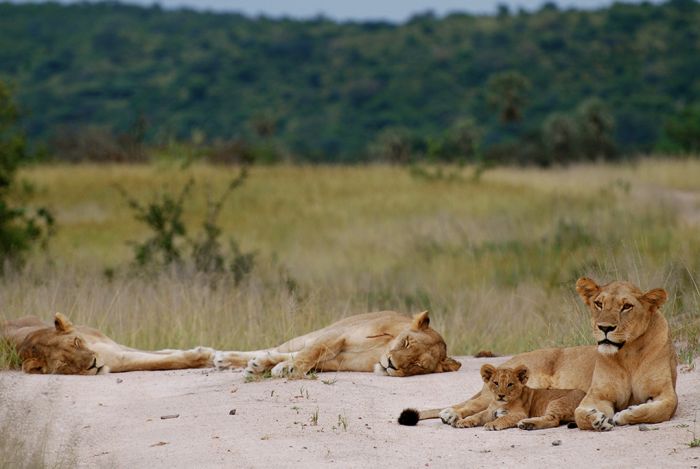
Lions in Nyerere National Park, Tanzania.
The crown jewel of the region is the combined protected area consisting of Nyerere National Park and Selous Game Reserve, the world's second-largest protected area and the largest in Africa. The Selous Game Reserve was named for the explorer Frederick Selous.
The Selous Reserve was partitioned in 2019, with the new Nyerere National Park (named for Julius Nyerere, the country's first leader upon gaining its independence), giving added protection to roughly two-thirds of the reserve. The combined park and reserve are home to an estimated 700 000 large mammals, including Africa's largest concentrations of elephant, leopard, buffalo, African wild dog, crocodile, and hippo.
The Rufiji River runs through the northern sector of the park/reserve and this is the setting for the safari camps and lodges in Nyerere/Selous. The reserve is famous for its remote setting and a feeling of being in Africa as it was hundreds of years ago. Most camps offer walking safaris and some offer seasonal boating on the river and lakes.

Large herd of buffalos in the dry Great Ruaha River.
Ruaha is Tanzania's largest national park and one of its least visited wildlife destinations, making it a very well kept secret, as the safari experience here is excellent. Ruaha is located in a transitional zone between East and Southern Africa, so the diversity of animals and plants here is exceptionally diverse. The safari camps are located along the Great Ruaha River, which courses through the eastern portion of the park.
Saadani National Park is East Africa's only wildlife reserve with an ocean border. It's unique location combines marine, riverine, and terrestrial habitats and visitors can experience a wide range of activities, including game drives, bush walks, boating on the Wami River, and cultural tours. The wildlife viewing is good, but not on a par with reserves like Serengeti or Ruaha.
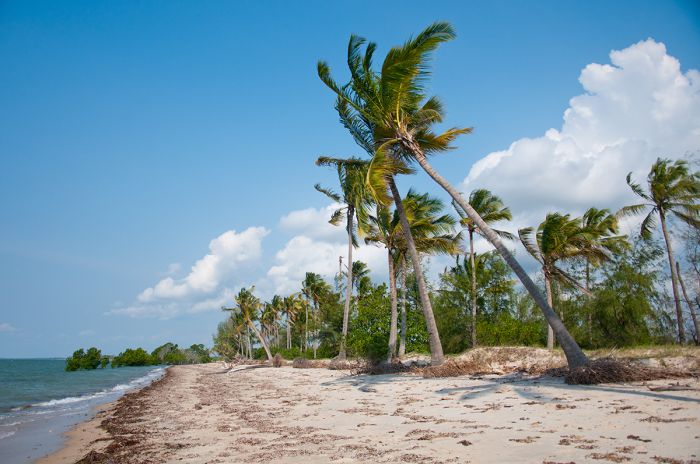
Coconut palms on the beach, Saadani National Park.
Dar es Salaam is Tanzania's largest city and the gateway for most tours of this region. "Dar" is a bustling, Indain Ocean port city with a rich history. It is worth considering spending a day or two to explore the city before heading out on safaris.
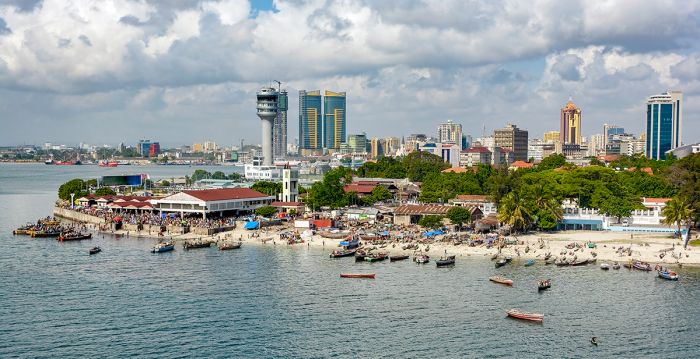
Fishing boats in front of Kivukoni fish market, Dar es Salaam.
Read More...
Dar es Salaam, History, Kitulo National Park, Mikumi National Park, Nyerere National Park, Ruaha National Park, Saadani National Park, Selous Game Reserve, Udzungwa Mountains National Park
History
Tanzania is the setting for some of our planet's earliest hominids. Discoveries of prehistoric fossils at Olduvai Gorge (in the Ngorongoro region) date back roughly 3 million years. These early hunter-gatherer hominids survived in the area for millennia, eventually replaced by pastoralist people several thousands years ago.
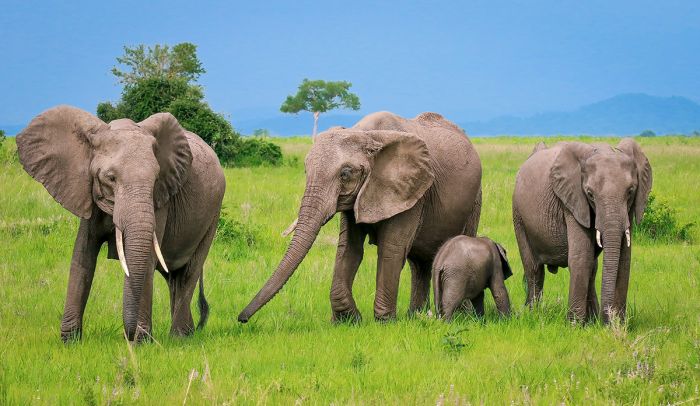
Elephants in Mikumi National Park, Tanzania.
The first Europeans to explore southern Tanzania were the British team of John Speke and Richard Burton, whose well-documented expedition between 1856-1859 hoped to determine the source of the Nile River.
In 1871, the acclaimed Frederick Courtney Selous left England for Africa, where he spent the next 40 years hunting and exploring the region. Selous served as a safari guide and was well acquainted with other historical figures including Theodore Roosevelt and Cecil John Rhodes, and was often referred to as the "Great White Hunter". Selous famously wrote about his many adventures and was the subject of many more books.
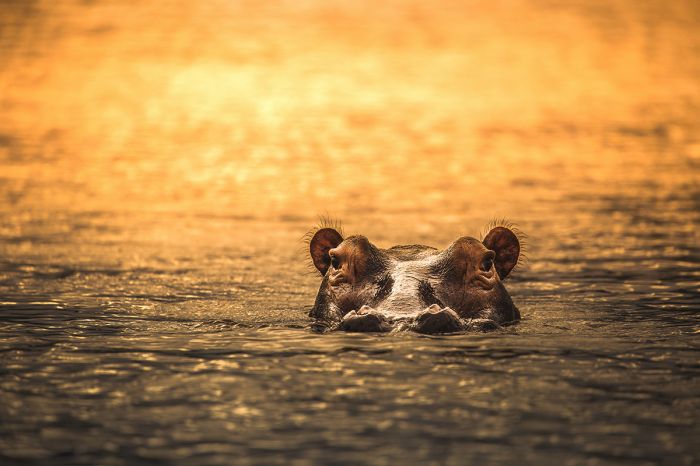
Hippo in Lake Tagalala, Nyerere National Park.
During World War I in 1916, Selous, now in his 60s, was appointed Captain of the 25th Royal Fusiliers and charged with pursuing the Germans in Southern Tanzania. On New Years' Day 1917, Selous and his troops encountered German troops led by Colonel Von Lettow in the Battle of the Bundu. During the battle, Selous was killed by a sniper along the Beho Beho River. His grave marks the spot and the Selous Game Reserve honors his name.
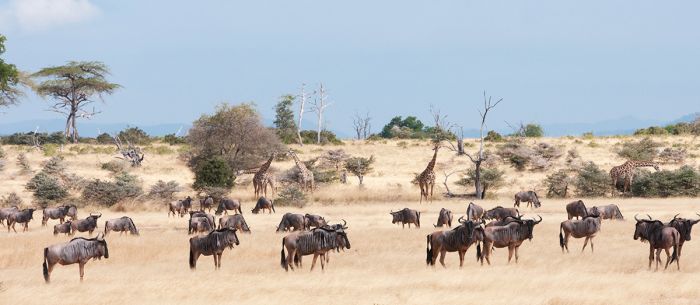
Blue wildebeests and giraffes in Nyerere National Park, Tanzania.
Selous Game Reserve / Nyerere National Park
Created in 1922 and covering 21 000 square miles (54 600 sq kms) of wilderness, the Selous Game Reserve (pronounced "sell-oo") (as of 2019 a combined national park and reserve) is Africa's largest single protected sanctuary. It's about three times the size of South Africa's Kruger National Park and twice the size of Serengeti National Park. It is one of Tanzania's three UNESCO World Heritage Sites (declared in 1982).
Note: The newly established (in 2019) Nyerere National Park now gives added protection (no trophy hunting) to the majority of the Selous.
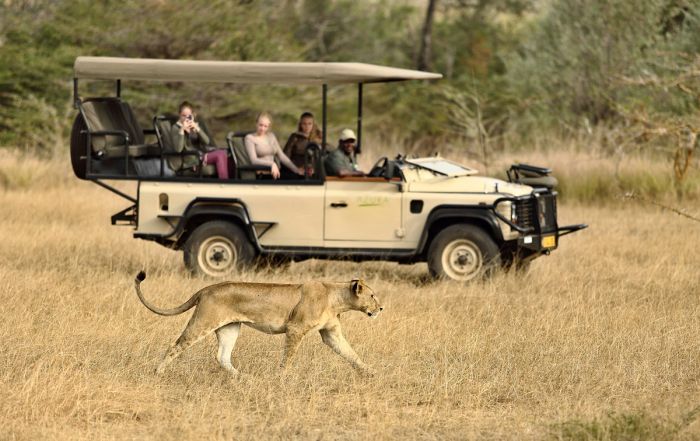
Game drive and lion in Selous.
Combined with the adjoining Mikumi National Park, this diverse ecosystem includes grassy plains, palm-lined rivers, marshland, open woodland, baobab forest, hilly scrubland, and groundwater forest. Wildlife in Selous is abundant and diverse, with an estimated 700 000 large mammals, including healthy populations of elephant, buffalo, lion, leopard, cheetah, spotted hyena, African wild dog, giraffe, zebra, hippopotamus, crocodile, and many other species. There are reportedly still over 100 highly endangered black rhinoceros in the reserve.
The Selous is mostly undisturbed by human impact and contains some of the most beautiful wilderness anywhere in Africa. The Rufiji River, which runs for 373 miles (600 kms), defines the southern border of the northern sector (now the border between the national park and the reserve). The Rufiji and its numerous tributaries provide prime wildlife habitat, including lagoons, small channels, swamps, small islands, and lakes harboring large numbers of hippos and crocodiles. The northern sector along the Rufiji River is the prime game viewing area and the location of most of the safari camps.
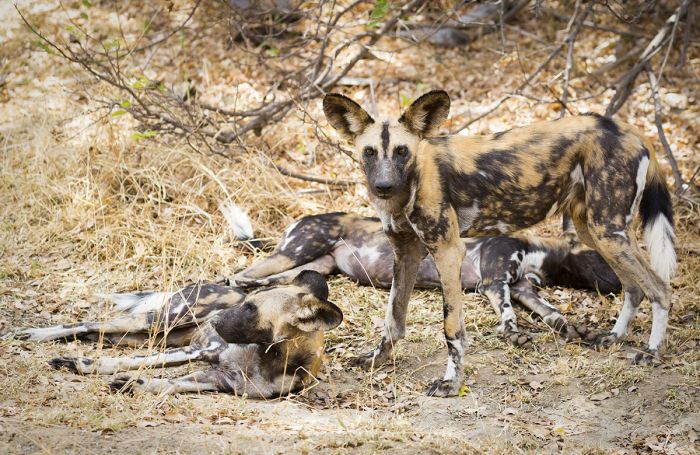
Nyerere/Selous has Africa's largest population of African wild dogs.
Elephants are common in Selous, as well as a good diversity of antelopes, including impala, puku, waterbuck, wildebeest, reedbuck, Roosevelt's sable, and Lichtenstein's hartebeest. The forested areas along the rivers and lagoons are home to large numbers of vervet monkeys, yellow baboons, blue monkeys, black-and-white colobus monkeys, and red colobus monkeys. Bird life is outstanding in Selous, especially from November through April, with over 400 species recorded.
The Selous is also a great place to see predators. Lions are the most commonly seen big cat, especially along the rivers. The abundance of prey means that the lions live in large prides in the reserve. Leopards are very common but more difficult to see. Cheetah and spotted hyena are also sometimes seen. Selous is also home to Africa's largest remaining population of the endangered African wild dog.
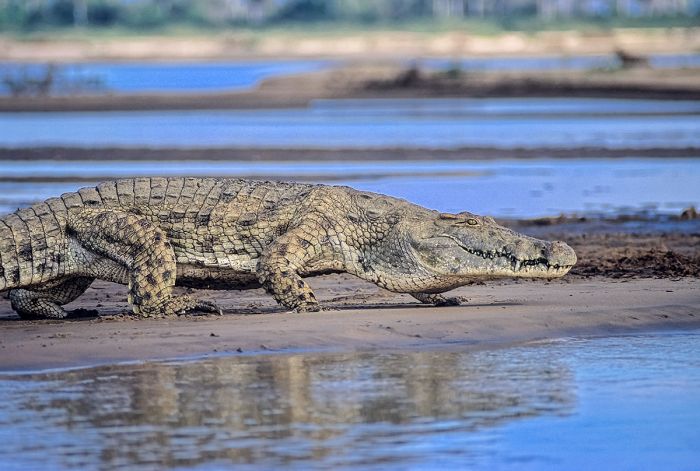
A Nile crocodile at the Rufiji River, Nyerere National Park, Tanzania.
The camps in Nyerere / Selous offer legendary walking safaris and boating on the Rufiji River and its surrounding lakes, providing guests with a much more diverse safari experience. Arrival in Selous is usually via small aircraft flights from Dar Es Salaam or Arusha to various private airstrips located at the safari camps.
Nyerere National Park
In 2019, the Tanzanian government decided to eliminate hunting in the eco-tourism sector (north of the Rufiji River) of the Selous Reserve, as well as in a vast area in the central and southern sectors of the reserve, with an eye on further developing eco-tourism in that remote area. The decision resulted in the establishment of the new Nyerere National Park, named for Julius Nyerere, independent Tanzania's first leader.
Prior to the establishment of the national park, the vast majority of the reserve (~95%), including everything south of the Rufiji/Great Ruaha Rivers, was set aside as trophy hunting concessions. Today, more than half of the original Selous Reserve is now fully protected from hunting as the Nyerere National Park (see the map at the top of this page).
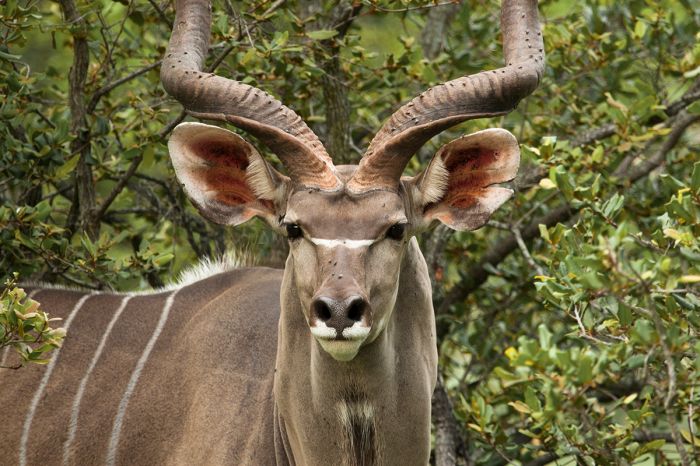
A greater kudu in Nyerere National Park, Tanzania.
RUAHA NATIONAL PARK
Declared in 1964 and covering 7 840 square miles (20 300 sq kms) along Tanzania's Rift Valley, Ruaha is Tanzania's second-largest national park (after Nyerere NP). It is the core of a much larger protected area that includes three additional contiguous game reserves: Rungwa, Kizigo, and Muhesi. Ruaha is one of the least visited wildlife sanctuaries in the country and visitors will enjoy a true wilderness experience.
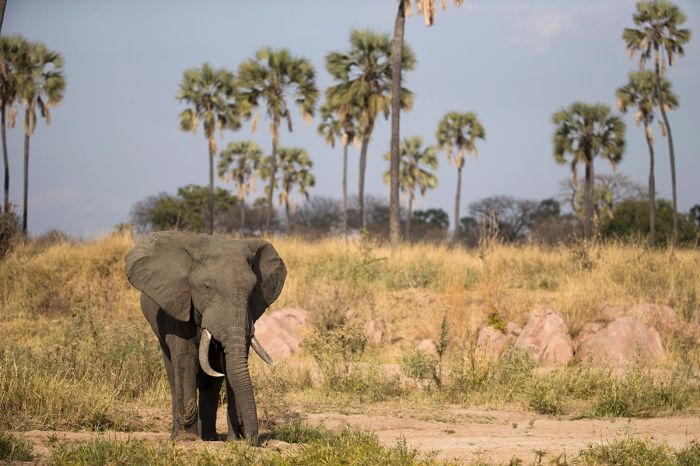
Elephant in Ruaha National Park.
The Great Ruaha River courses through the park and combined with the park's location in the transitional zone between Eastern and Southern Africa, it provides a wonderful diversity of life. Over 1 500 plant species and all the wildlife one can see in the northern parks are also present in Ruaha.
The habitats in Ruaha are varied, including riparian forest along the waterways, grassland, Acacia woodland, and swamp. There are numerous large baobab trees in some areas of the park and the overall scenery is quite similar to that in Tarangire to the north.
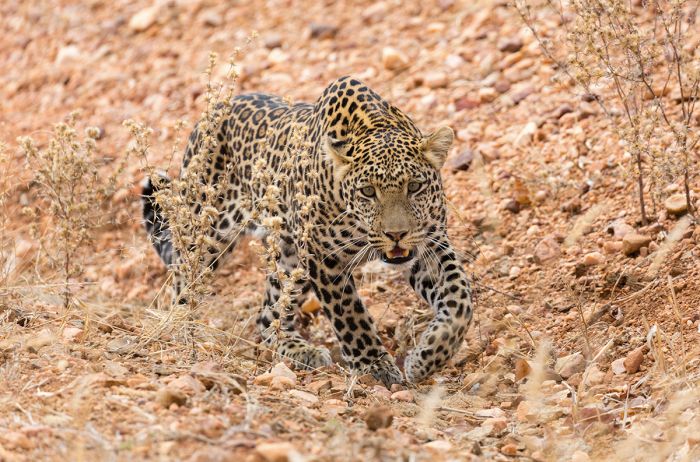
A leopard on the move in Ruaha National Park, Tanzania.
Ruaha is home to large numbers of elephant, plus a number of lesser known antelopes, like sable, roan and lesser kudu. The park also contains big herds of buffalo, as well as good numbers of zebra, eland, Grant's gazelle, impala, giraffe, defassa waterbuck, reedbuck, klipspringer, greater kudu, bushbuck, Liechtenstein's hartebeest, and Kirk's dik-dik.
Predators include healthy populations of lion, leopard, cheetah, African wild dog, spotted hyena and crocodile. Birding in Ruaha is excellent, with over 500 species recorded.
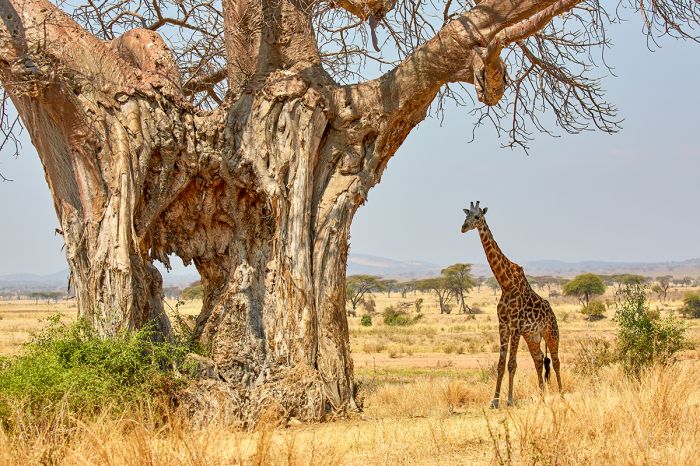
A Masai giraffe and baobab tree in Ruaha National Park.
The park has several good lodges and camps situated along the Great Ruaha river in the southeastern sector of the park. Game drives on tracks that follow the river provide excellent wildlife viewing. For the more intrepid, bush walks with trained guides are on offer.
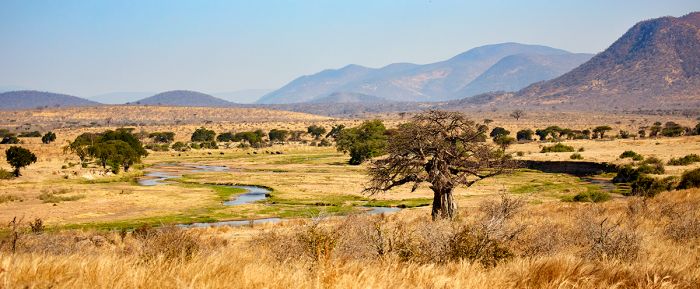
Distant herd of elephants along the Great Ruaha River.
SAADANI NATIONAL PARK
Saadani National Park is a 410-sq-mile (1 062-sq-km) reserve located on the Indian Ocean coast north of Dar es Salaam. The park is unique in that it combines terrestrial, marine and riparian habitats. Gazetted in 2005 (previously a hunting area), the game viewing is improving and several safari camps have been constructed here.
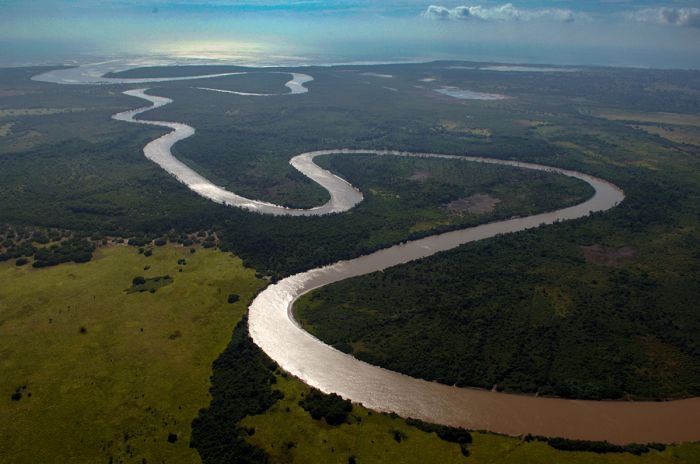
The Wami River flowing to the Indian Ocean in Saadani National Park, Tanzania.
Safaris in Saadani are conducted via game drives, bush walks and boating on the Wami River. The are over 30 large mammal species including lion, leopard, elephant, buffalo, zebra, warthog, Masai giraffe, Lichtenstein's hartebeest, greater kudu, common waterbuck, Roosevelt's sable, roan antelope, blue wildebeest, yellow baboon, and several species of monkey. Crocodile and hippo are plentiful in the river.
The birding is fantastic, especially along the rivers and the park has over 330 species on its list.
Wildlife on the beach is uncommon, though baboons and waterbuck are sometimes seen. Snorkeling is on offer and dolphins and small sharks may be seen. Green turtles nest along Saadani's beach and conservation occurs at the Incubation and Hatching Centre.
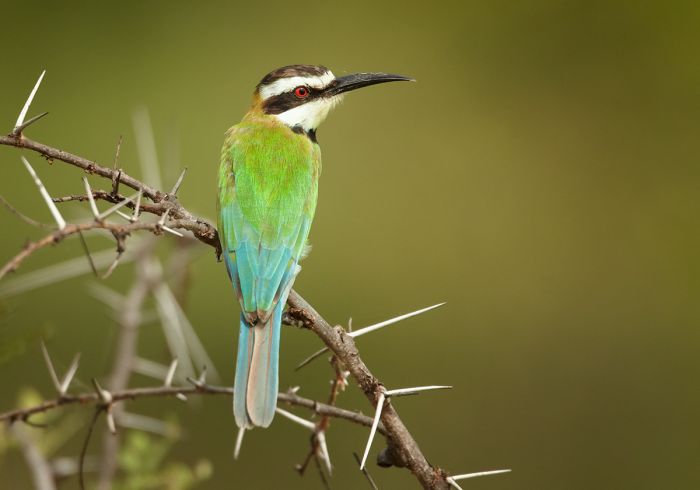
A white-throated bee-eater in Saadani National Park.
June to October are the best months for Saadani, as it is drier and animals tend to be closer to the river. January and February are lovely and lush after the rains. Rains are heaviest in April and May and roads may sometimes be unusable.
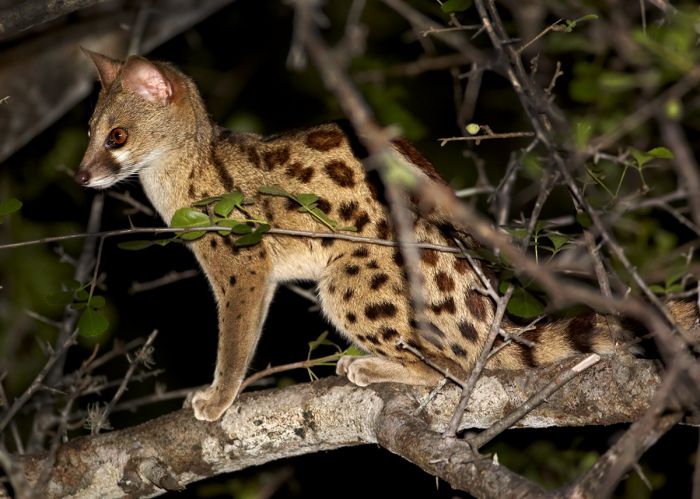
A large-spotted genet in Saadani National Park, Tanzania.
DAR ES SALAAM
Dar es Salaam, known simply as 'Dar', is Tanzania's most populous city with over 4 million people and it continues to grow. Previously the capital city (now moved to Dodoma), Dar continues to be the focus of government bureaucracy and the most prominent Tanzanian city in terms of business, finance, arts, media and music.
Julius Nyerere International Airport (DAR) is the busiest point of entry in Tanzania and scheduled or chartered flights leave for almost any destination in the country.
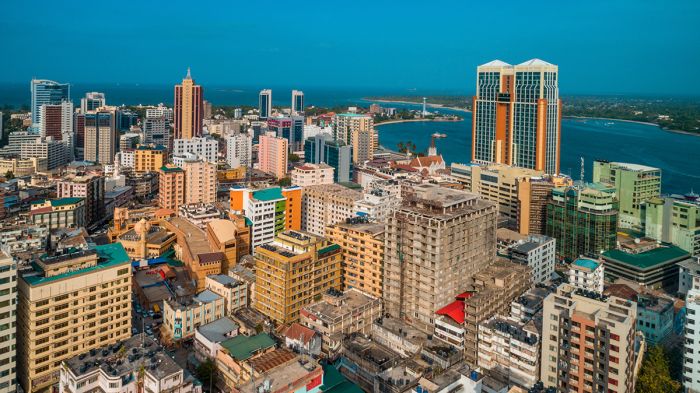
Dar es Salaam on Tanzania's Indian Ocean coast.
Dar is also the leading arrival and departure point for most tourists. Despite experiencing strong economic growth over the past decade, over 70 percent of the city's population live in slums, surviving without electricity, running water, or basic sanitation.
Dar was established in 1862, when Zanzibar's Sultan, Majid bin Said of Zanzibar, built a summer palace here, which he hoped would replace Stone Town as the capital of the Busaïdi dynasty. The location was ideal to take full advantage of the flourishing ivory and slave trade.
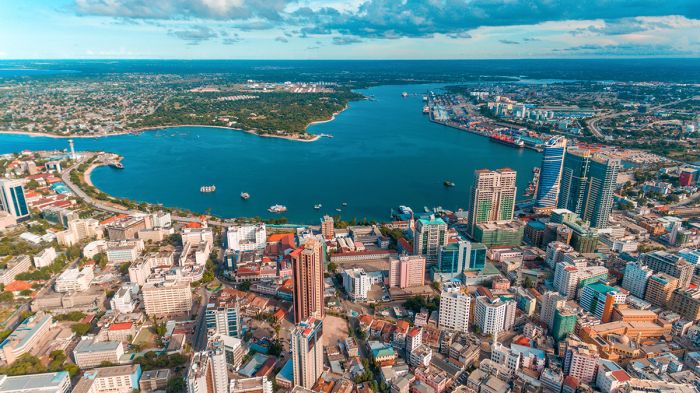
Aerial view of Dar's harbor (looking inland from the coast).
Germany established a colonization station at Dar in 1887 and construction of the city began. In the early 1900s, the Central Line Railway was constructed to connect Central Africa to the coast via Lake Tanganyika and after World War I, to Lake Victoria as well. This cemented Dar's economic importance.
Following the war, the British took over the country and retained Dar as the commercial and administrative center. In 1961, the country gained its independence from Great Britain.
Dar has a wide selection of hotels, many of which are along the ocean. From October to February, the weather can be very hot and humid, so be sure to request a room with air conditioning or select one of the beach hotels just outside the city.
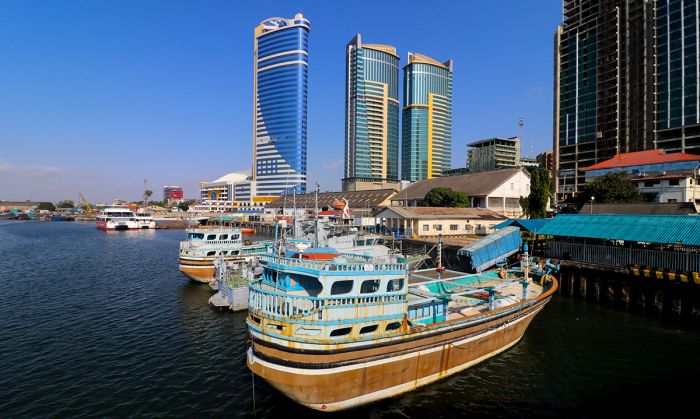
Boats in the harbor, Dar Es Salaam, Tanzania.
UDZUNGWA MOUNTAINS NATIONAL PARK
The Udzungwa Mountains National Park is a forested wilderness covering 768 square miles (1 990 sq kms) of some of the richest and most biodiverse land on the planet. It was declared a national park in 1992.
Due to the steep terrain, which has mostly limited human intervention to the low-lying areas, the forests on these mountains are virtually pristine. The virgin forest canopy in the mountain range extends from 800-6 500 feet (250-2 000 meters), with Miombo woodlands, bamboo and towering lowland forests.
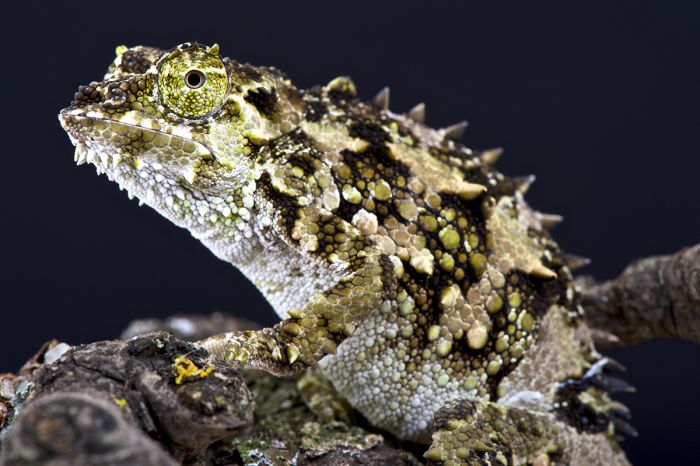
The spiny-flanked chameleon, and endemic of the Udzungwa mountains.
Udzungwa is one of Africa's most biodiverse parks, with over 2 500 species of flora, of which 25% are endemic, 400+ species of bird, and and unknown but large number of butterflies. The highest peak in the park is Lomero, which rises to 8 450 feet (2 576 meters).
Primates are abundant here, with twelve species calling these forests home. There are four endemic primates in the park (Sanje crested mangabey, the Iringa red colobus, and two species of dwarf bushbaby). Other mammals include elephant, buffalo, a variety of duikers (Harvey's red, Abbott's, and blue), bushbuck, klipspringer, bush pig, civet, honey badger, and others. Leopard live in the park, but are almost never see.
Activities in Udzungwa are restricted to hiking in the forest (there are no roads). There are various hiking trails that vary in difficulty and duration form the one-hour Sonjo Trail to the challenging six-day Lumemo Trail, which requires bringing camping gear and supplies. The four-hour Sanje Waterfall trail leads to a beautiful 558-foot (170-meter) high waterfall and hikers can swim in the plunge pool below the falls. The best time to visit is during the dry months from June to October and December to February.
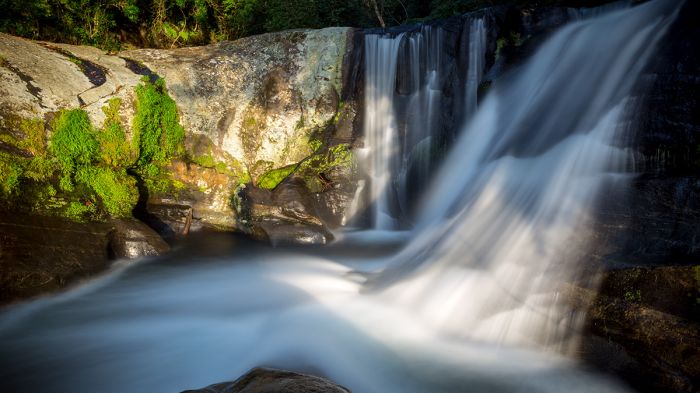
Waterfall in Udzungwa Mountains National Park, Tanzania.
Mikumi National Park
Created in 1964, the 1 250-square-mile (3 230-sq-km) Mikumi National Park adjoins Nyerere National Park to the north and provides a similar game viewing experience, albeit without the mighty Rufiji River. Most of the game viewing is conducted in the sector northwest of the Tanzam Highway, which lamentably passes through the park. The highway is the main reason that Mikumi is not typically featured on safari itineraries.
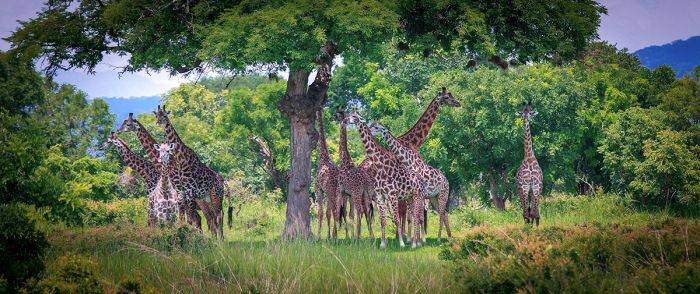
Giraffes in Mikumi National Park, Tanzania.
Plains game is abundant in Mikumi, with large herds of zebra, wildebeest, impala, and buffalo. Elephants are commonly seen, as are giraffe, waterbuck, eland, greater kudu, sable, bohor reedbuck, warthog, and troops of yellow baboon and vervet monkey. Predators include lion, which are usually not hard to find, as well as spotted hyena, black-backed jackal, and African wild dog. More than 400 species of birds have been recorded.
Accommodations include an assortment of basic lodges and camping sites inside the park, as well as other choices outside the park, but near enough to allow day trips into the park. Game viewing in Mikumi is best during the dry months between June and October.
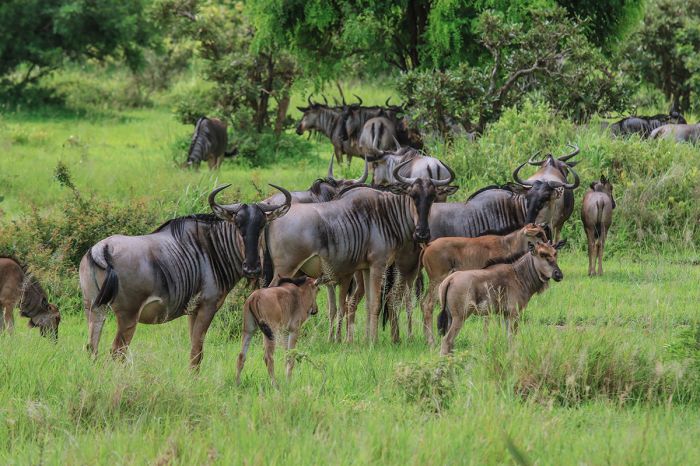
Blue wildebeests in Mikumi National Park.
Kitulo National Park
Established in 2005 and covering 160 square miles (413 sq kms), Kitulo is a little-visited sanctuary set aside to protect its diverse flora. The park is perched at 8 500 feet (2 600 meters) and consists of a highland plateau of afro-alpine grassland in the northern sector and montane forests in the southern and western and sectors.
The park is situated in the northern part of the Livingstone Mountains (also known as the Kipengere Range).
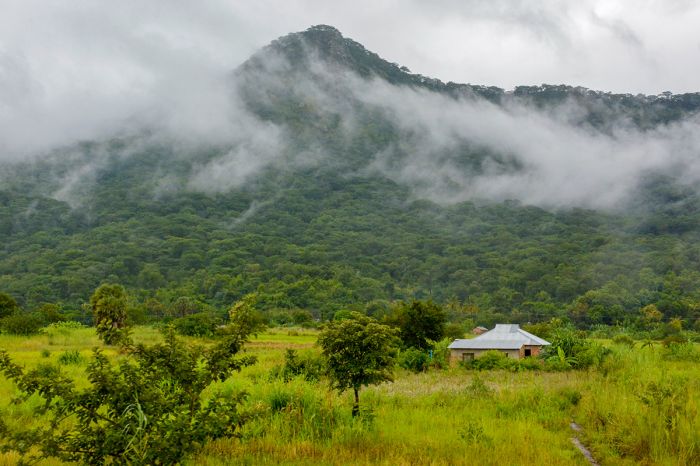
Scenery in the foothills of Kitulo National Park.
Known locally as Bustani ya Mungo ("Garden of God"), the park is a paradise for botanists, with huge numbers of endemic wildflowers, including over 50 species of terrestrial orchid. The park's floral diversity is due to its rich volcanic soils and plentiful rainfall.
The rainy season (Nov-May) is the best time to visit, when the plateau explodes in a profusion of colorful flowers. Birding and butterfly enthusiasts will find the park heavenly.
The park's infrastructure is limited, but there are some good trails for those who want to explore. Visitors to Kitulo can self-camp inside the park or find lodging in the town of Mbeya, which is situated just west of the park.
Read More...
Dar es Salaam, History, Kitulo National Park, Mikumi National Park, Nyerere National Park, Ruaha National Park, Saadani National Park, Selous Game Reserve, Udzungwa Mountains National Park
Great Good Fair Poor
- Jan
- Feb
- Mar
- Apr
- May
- Jun
- Jul
- Aug
- Sep
- Oct
- Nov
- Dec
Overview
Game viewing peaks from July to September/October, during the driest months when animals are drawn to the rivers and lagoons. Birding is good all year, but January/February is the best.
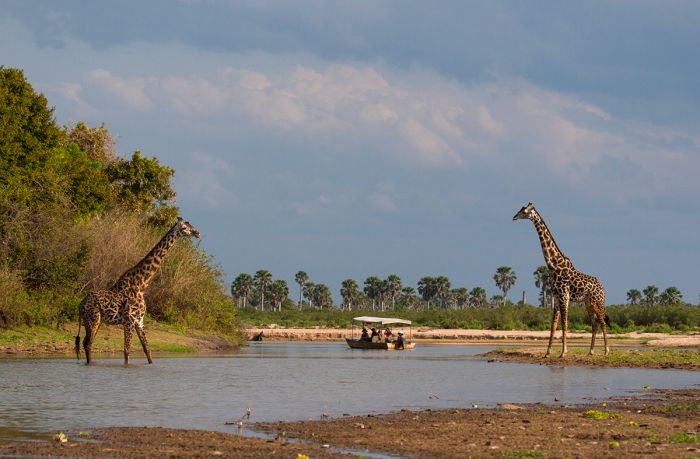
Giraffes and boating safari in the Rufiji River, Nyerere National Park.
The short rains fall for about one month during November-December, but most camps remain open. The long rains fall from mid-March to late May and many camps close during this period due to poor road conditions.
The game reserves in Southern Tanzania experience consistently warm temperatures throughout the year, with daytime temps averaging 82-86°F (28-30°C) and nights falling to 69-72°F (20-22°C).
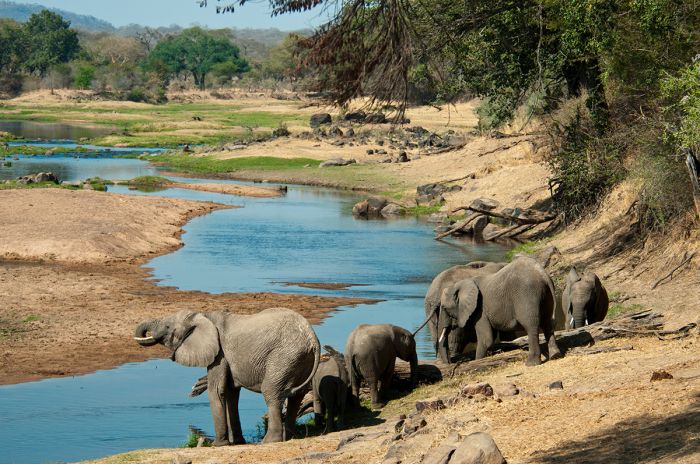
Elephants drinking at the Great Ruaha River, Tanzania.
Seasons
The first rains generally arrive sometime in November, with short afternoon showers that are unlikely to interfere with safaris. After the short rains end (sometime in December), January and February are mostly beautiful, with fresh green grass, migratory birds arriving from the north, and only occasional rain.
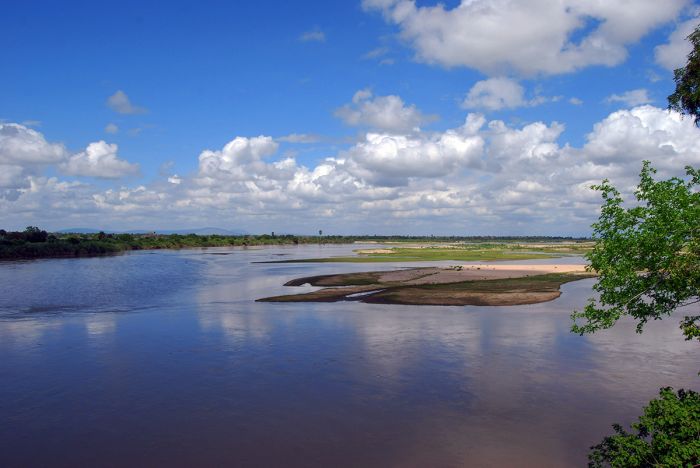
View over the Rufiji River in Nyerere National Park, Tanzania.
March and April are the rainiest months and most days receive some showers. Roads often become very bad and these months should be avoided. May receives some rain, but by June the rains have mostly abated.
June thru October is the dry season, with clear sunny days the norm. Rain is rare to nonexistent. The landscape dries more every day and game viewing becomes progressively better. This is a great time to go on safari in Southern Tanzania.
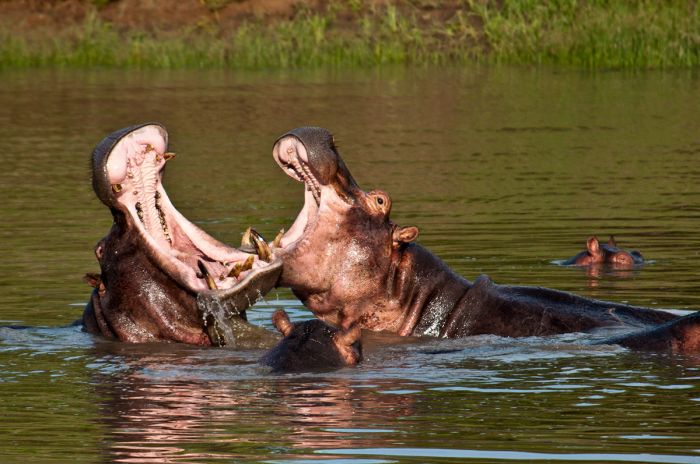
Hippos in the Great Ruaha River.
Showing 1–4 of 4 results
Stylish and contemporary camp situated in Ruaha's prime wildlife location. Spectacular scenery, abundant wildlife, day and night game drives, epic bush walking, and conservation experiences.…
Classic, tented camp situated in Ruaha's prime wildlife location on the banks of a river. Spectacular scenery, diverse wildlife, day and night game drives, excellent guides, bush walking, and conservation experiences.…
Located in The Selous, a vast wilderness and Africa's largest wildlife sanctuary. Abundant wildlife, diverse landscapes, game drives, bush walks, boating safaris, and catch-release fishing. No crowds. Perfect add-on to Serengeti safari.…




